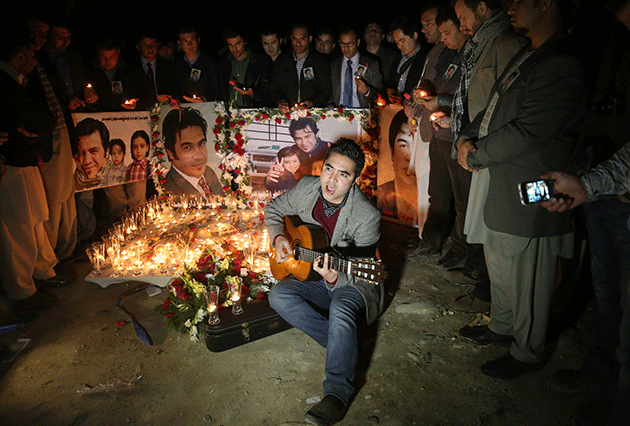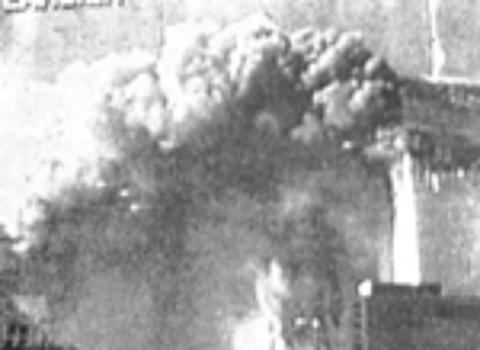
Colleagues and friends gather to remember Afghan journalist Sardar Ahmad during a memorial in Kabul, Afghanistan, Wednesday, March 26, 2014. © AP Photo/Massoud Hossaini
A veteran reporter of the war in Afghanistan, Ahmad Sardar had surely expected death many times, but not the way it happened — on the eve of Nowruz, the Persian New Year, as he sat around a table at Kabul’s Serena Hotel with his wife, Humaira; his daughter, Nelofar; and his sons, Omar and Abuzar.
Four Taliban gunmen, all under the age of twenty, had entered the hotel carrying pistols and ammunition in their socks and shoes. They hid in a bathroom, retrieving their weapons before making their way to one of the hotel’s restaurants, where they opened fire on the diners there, killing four members of the Sardar family — Ahmad, Humaira, Nelofar, and Omar — along with one other Afghan and four foreigners. (Abuzar, Sardar’s youngest child, emerged from a coma on Sunday.) A police photograph of the scene shows the extent of the heartbreak: in one, Nelofar’s small fingers stretch toward those of her mother; in another, Omar lies, his eyes gently closed, in a pool of blood.
This Monday, several days after the shooting, the bodies of Sardar and his family were transferred out of Kabul’s military hospital, where they had been kept until out-of-town relatives arrived in the city. Verses of the Koran blared from a set of loudspeakers outside the hospital as a spring rain drenched the arriving mourners. Inside the building, the caskets of Ahmad and Humaira, covered in Afghan flags, sat beside each other on a table. Below them, at their feet, were the caskets of Nelofar and Omar, both draped in green. Each casket had a garlanded photo in front of it. All those who entered the room to pay their respects — family, friends, colleagues, government officials — wept. What broke me was the portrait of Nelofar. “I am in love with her eyes,” Sardar had often told his friends.
The caskets were loaded into four ambulances, and the long funeral convoy made its way through the buzzing streets of Shar-e Naw. In his final days, Sardar had made a habit of posting photos of such neighborhoods each morning — the balloon sellers, the fruit stalls, the street cats mid-copulation, the often misspelled scrawlings on the back windows of cars. The convoy turned left at Haji Yaqub Square, near the offices of Pressistan, the fixing-and-translation service Sardar founded in 2009, where he worked in his hours off from reporting for Agence France-Presse. On his desk there, under a scattering of red and yellow rose petals, was his reporter’s notebook, open to the page containing notes from his final AFP story. It was about a rescued lion cub at the Kabul Zoo — “named Marjan,” Sardar had scribbled, “after the lion that became popular for surviving the civil war.” I was reminded of a Facebook post Sardar wrote last July in which he described a conversation with Nelofar. “Baba, do the Taliban kill animals as well?” Nelofar, who was five at the time, had asked. “No!” he had replied. “I wish we were animals,” she had said.
As the ambulances approached the square, a traffic officer blocked the intersection so that the convoy could pass unhindered. (Sardar had once complained jokingly to a friend at the Ministry of Interior Affairs of being distracted by this officer’s police whistle. The friend had suggested an easy solution: “Close your office window.”) As the rain continued, the convoy drove on toward the family’s resting place, in Kabul’s Qala-i-Zaman Khan neighborhood. In another part of this resilient city, people were gathered to celebrate the Farmer’s Festival, held on the second day of Nowruz. But here the shovels were used to dig four graves.
What was impressive about Sardar was his unflagging enthusiasm for finding new angles, new platforms — something increasingly rare in his generation of Afghan reporters, many of whom have moved on to new careers, exhausted by more than a decade of conflict. In our final conversation together, about a month ago, Sardar asked for my help in starting a magazine that would focus exclusively on narrative journalism. As Ben Sheppard, Sardar’s AFP bureau chief, wrote in an online tribute, “He loved the story in Afghanistan, had a deep knowledge of the news, and an effortless ability to explain the country to outsiders.” Journalists have been murdered before in this country, and they will be again. But this murder was different, not only because Sardar had a rare talent but also because the violence extended to his wife and children. When Nelofar’s garlanded photograph was put on her headstone in Qala-i-Zaman Khan, her eyes seemed to tell those gathered, in the words of the Afghan poet Abdul Bari Jahani, “Sleep will escape your eyes, you will remember me every breath.”





